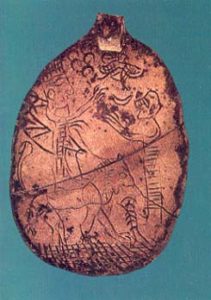Buried Philistine Treasures Unearthed at Tel Miqne-Ekron, BAR 19:01, Jan-Feb 1993.
 Buried treasure! For many people, these words evoke the most exciting and romantic notions of the past. And despite what you may have heard, buried treasures can still be found outside the pages of books or the frames of film. When found in a scientific excavation, however, buried treasure can be more than a bauble of romance; it can become important evidence of an ancient people’s actions in response to a crisis, a legacy that imparts the drama of an historic event. Such was the case recently at Tel Miqne, site of Biblical Ekron, one of the five capital cities of the Philistines.a In their 1992 excavations of the city, destroyed by the Babylonians in 603 B.C., co-directors Trude Dothan and Seymour Gitin made not one, but two discoveries of buried treasure.
Buried treasure! For many people, these words evoke the most exciting and romantic notions of the past. And despite what you may have heard, buried treasures can still be found outside the pages of books or the frames of film. When found in a scientific excavation, however, buried treasure can be more than a bauble of romance; it can become important evidence of an ancient people’s actions in response to a crisis, a legacy that imparts the drama of an historic event. Such was the case recently at Tel Miqne, site of Biblical Ekron, one of the five capital cities of the Philistines.a In their 1992 excavations of the city, destroyed by the Babylonians in 603 B.C., co-directors Trude Dothan and Seymour Gitin made not one, but two discoveries of buried treasure.
One treasure was found triply secured in a seventh-century B.C. building where archaeologists earlier had discovered cultic inscriptions and several four-horned altars. The treasure had been placed within a jug that was in turn placed within another vessel and then buried beneath the floor of the building. Inside the broken jug, archaeologists found 77 silver ingots, and a gold bead, visible just above the ingots in the photo. The ingots are folded and elongated in shape and weigh more than two pounds altogether. According to professors Dothan and Gitin, these ingots served as a kind of currency in the seventh century B.C., at about the same time that minted coins first began to come into use. This cache may have been hidden just before the Babylonian siege of Ekron.
The second treasure turned up in one of the totally destroyed, seventh-century B.C. rooms on the city’s acropolis.
A cache of 31 pieces of jewelry lay in the hole of a large perforated stone weight, probably secreted there during the city’s final desperate hours. This is the third such hidden trove of jewelry found at Tel Miqne-Ekron. In addition to beads, earrings, a cameo and a ring with a hieroglyphic inscription, the cache contained a silver medallion bearing an incised picture. The scene, which resembles images from the same period that were previously discovered in Turkey, depicts a person with arms raised in worship, right, and a goddess standing on a lion, left.



